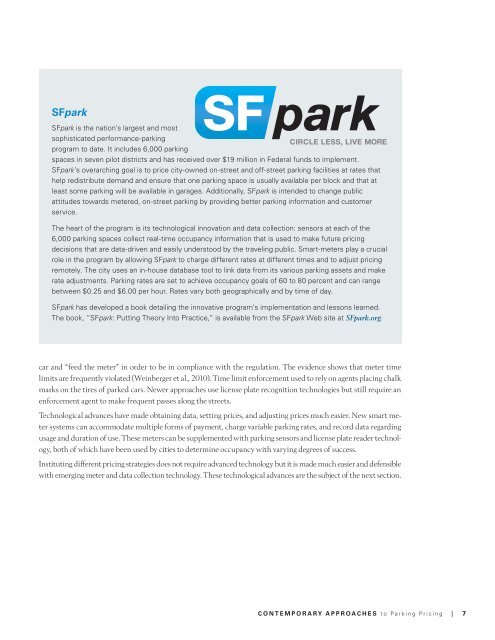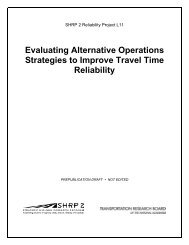Contemporary Approaches to Parking Pricing: - FHWA Operations
Contemporary Approaches to Parking Pricing: - FHWA Operations
Contemporary Approaches to Parking Pricing: - FHWA Operations
You also want an ePaper? Increase the reach of your titles
YUMPU automatically turns print PDFs into web optimized ePapers that Google loves.
SFpark<br />
SFpark is the nation’s largest and most<br />
sophisticated performance-parking<br />
program <strong>to</strong> date. It includes 6,000 parking<br />
spaces in seven pilot districts and has received over $19 million in Federal funds <strong>to</strong> implement.<br />
SFpark’s overarching goal is <strong>to</strong> price city-owned on-street and off-street parking facilities at rates that<br />
help redistribute demand and ensure that one parking space is usually available per block and that at<br />
least some parking will be available in garages. Additionally, SFpark is intended <strong>to</strong> change public<br />
attitudes <strong>to</strong>wards metered, on-street parking by providing better parking information and cus<strong>to</strong>mer<br />
service.<br />
The heart of the program is its technological innovation and data collection: sensors at each of the<br />
6,000 parking spaces collect real-time occupancy information that is used <strong>to</strong> make future pricing<br />
decisions that are data-driven and easily unders<strong>to</strong>od by the traveling public. Smart-meters play a crucial<br />
role in the program by allowing SFpark <strong>to</strong> charge different rates at different times and <strong>to</strong> adjust pricing<br />
remotely. The city uses an in-house database <strong>to</strong>ol <strong>to</strong> link data from its various parking assets and make<br />
rate adjustments. <strong>Parking</strong> rates are set <strong>to</strong> achieve occupancy goals of 60 <strong>to</strong> 80 percent and can range<br />
between $0.25 and $6.00 per hour. Rates vary both geographically and by time of day.<br />
SFpark has developed a book detailing the innovative program’s implementation and lessons learned.<br />
The book, “SFpark: Putting Theory In<strong>to</strong> Practice,” is available from the SFpark Web site at SFpark.org.<br />
car and “feed the meter” in order <strong>to</strong> be in compliance with the regulation. The evidence shows that meter time<br />
limits are frequently violated (Weinberger et al., 2010). Time limit enforcement used <strong>to</strong> rely on agents placing chalk<br />
marks on the tires of parked cars. Newer approaches use license plate recognition technologies but still require an<br />
enforcement agent <strong>to</strong> make frequent passes along the streets.<br />
Technological advances have made obtaining data, setting prices, and adjusting prices much easier. New smart meter<br />
systems can accommodate multiple forms of payment, charge variable parking rates, and record data regarding<br />
usage and duration of use. These meters can be supplemented with parking sensors and license plate reader technology,<br />
both of which have been used by cities <strong>to</strong> determine occupancy with varying degrees of success.<br />
Instituting different pricing strategies does not require advanced technology but it is made much easier and defensible<br />
with emerging meter and data collection technology. These technological advances are the subject of the next section.<br />
C o n t e m p o r a r y A p p r o a c h e s t o P a r k i n g P r i c i n g | 7















